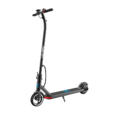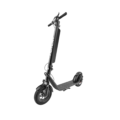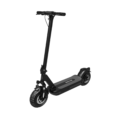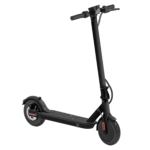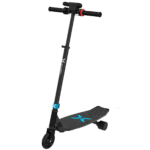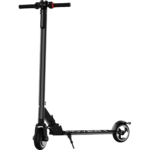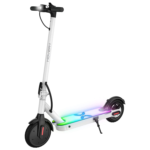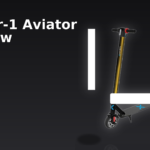- Home
- Scooters
- Electric Scooters
- Hover-1 Eagle
Hover-1 Eagle
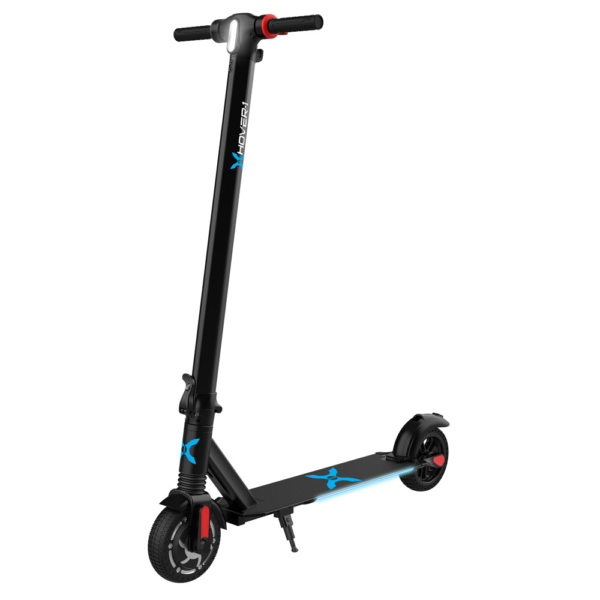

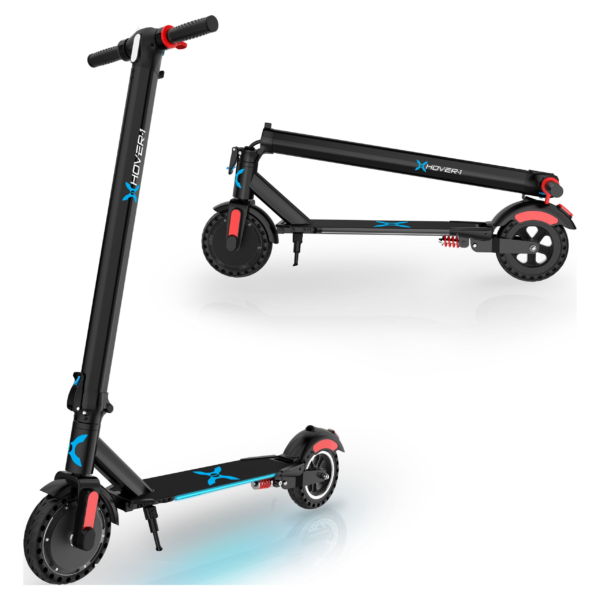
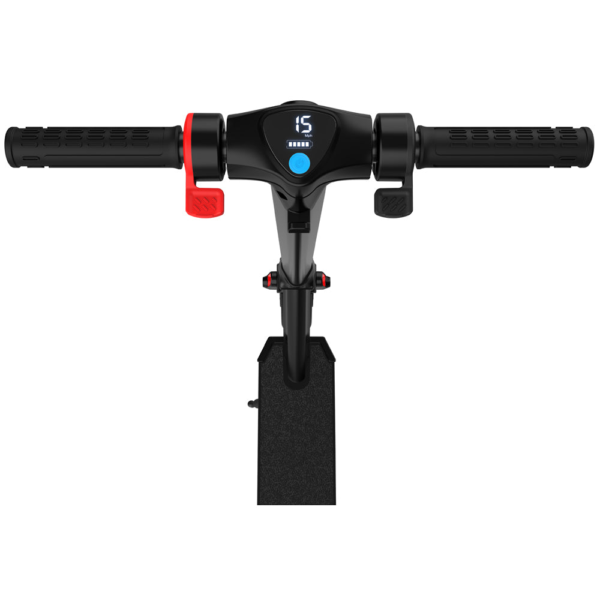
- Battery Range: 7 miles (11 km)
- Top Speed: 15 mph (24 km/h)
- Motor Power: 300 W
- Weight Capacity: 220 lb (100 kg)
- Charging Time: ≈5 h
- Scooter Weight: 20.9 lb (9.5 kg)
PROS
- Very light 20.9 lb
- Built-in suspension
- Front & rear brakes
- Deck LED + head/brake lights
- LCD display
CONS
- Short 7-mile range
- Solid 6.5″ tires ride firm
- IP rating not listed

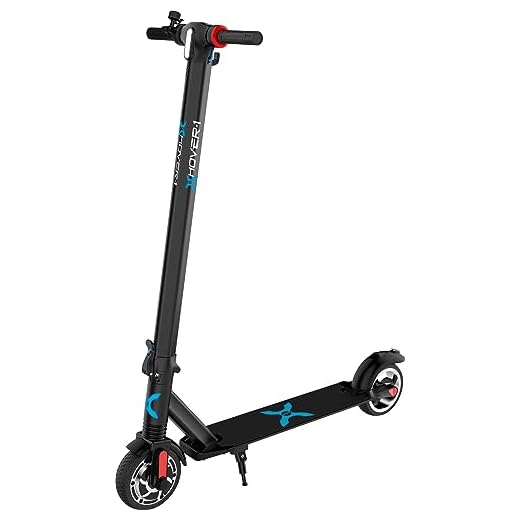
Table of contents
- What Is the Hover-1 Eagle?
- How the Hover-1 Eagle Works
- Key Specifications
- Design & Build Quality
- Performance Fundamentals
- Battery, Range & Efficiency
- Ride Quality & Comfort
- Braking & Safety Features
- Portability & Daily Usability
- Maintenance & Care
- Weather & Seasonal Considerations
- Hover-1 Eagle vs Alternatives
- Who the Hover-1 Eagle Is (and Isn’t) For
- FAQs
- Glossary
- Final Thoughts
The Hover-1 Eagle is a lightweight, foldable electric scooter built for short, simple trips. It prioritizes ease of use over raw power, with a modest 36V system, small solid tires, and an intuitive cockpit that suits first-time riders and teens. If you’re comparing compact city rides, you might also look at the JOYOR F3 as a reference point for an alternative commuter setup. Consequently, if you want a compact last-mile option for flat urban paths, the Hover-1 Eagle hits a practical sweet spot while staying friendly on weight and maintenance.
What Is the Hover-1 Eagle?
At its core, the Hover-1 Eagle is a beginner-friendly kick-to-start e-scooter with a 320W brushless hub motor, a 36V/4Ah lithium-ion battery, and 6.5-inch non-pneumatic (solid) tires. It folds quickly, stores easily, and keeps the interface simple: an LCD display, two speed levels (P1/P2), a thumb throttle, and a basic brake system with electronic braking up front and a mechanical rear fender brake. As for headline numbers, the official specifications rate top speed at up to 15 mph (24 km/h) and range at up to 7 miles (11.2 km). Meanwhile, with a net weight of about 20.9 lb (9.47 kg), it’s one of the easier electric scooters to carry up stairs, lift into car trunks, or stash under a desk.
While the Hover-1 Eagle is positioned for younger riders and new commuters, it is not a toy. The manufacturer lists a minimum supported rider weight of 44 lb (20 kg) and a maximum of 264 lb (120 kg), and it recommends riding on flat, even surfaces. Therefore, for those conditions, the Eagle provides a calm, predictable ride with a small learning curve.
How the Hover-1 Eagle Works
The Hover-1 Eagle follows the standard architecture you’ll find on many compact e-scooters, yet its choices aim at simplicity and low upkeep.
- Motor & Controller: A brushless hub motor built into the front wheel receives power from a compact controller. Think of the controller as the scooter’s “brain,” metering current from the battery to the motor when you press the throttle. As a result, because output is modest, the power delivery feels smooth rather than punchy.
- Battery & BMS: The 36V (nominal) battery is 4.0Ah, which equates to ~144 Wh of stored energy (36 × 4). Additionally, an onboard battery management system (BMS) handles charging safety and protects against conditions like over-discharge.
- Throttle: A thumb throttle on the right side lets you modulate speed finely. The display shows P1 (low speed) and P2 (high speed) modes. Moreover, double-tapping the throttle enables cruise control at your current speed; tap again to disengage.
- Brakes: The left lever actuates electronic braking (regen effect in the front motor). For extra stopping, you press the rear mechanical fender to add friction at the back wheel. Consequently, the combination is easy to learn and sufficient for the scooter’s speeds when used responsibly.
- Cockpit & Lights: The center LCD shows speed (mph by default), a battery indicator, headlight status, and a cruise icon. There’s a white headlight, a rear brake light, and a decorative foot-deck LED strip for visibility. Even so, you should still ride defensively.
Altogether, the Hover-1 Eagle trades high performance for convenience. It starts with a kick, ramps up smoothly, and rewards gentle inputs; therefore, new riders tend to feel at ease quickly.
Key Specifications
| Block | Details |
|---|---|
| General | Model: H1-EGE • Net weight: 20.88 lb (9.47 kg) • Max rider weight: 264 lb (120 kg) • Min rider weight: 44 lb (20 kg) • Recommended age: 8+ |
| Performance & Power | Motor: 320W brushless front hub • Top speed: up to 15 mph (24 km/h) • Tires: 6.5 in (front & rear), solid (non-pneumatic) • Speed modes: P1 (low), P2 (high) |
| Battery, Charging & Electrical | Battery: 36V / 4.0Ah (~144 Wh) lithium-ion • Range: up to 7 miles (11.2 km) • Charge time: up to 5 hours • Charging input: AC 100–240V, 50/60 Hz • Working temp: -4 to 140°F (-20 to 60°C) • Charging temp: 32 to 104°F (0 to 40°C) |
| Build & Dimensions | Open size: 38.5 × 15.7 × 44.7 in (97.8 × 40 × 113.5 cm) • Folded size: 38.5 × 15.7 × 16.5 in (97.8 × 40 × 42 cm) • Frame: aluminum • Kickstand: yes |
| Safety & Control | Braking: electronic (front) + mechanical rear fender • Lights: headlight, rear brake light, deck LED • Display: LCD with speed, battery, indicators |
| Features & Extras | Cruise control (double-tap throttle) • Kick-to-start • Front spring for small-bump comfort • Tool kit & wall charger included |
| Warranty & Compliance | Warranty: 90-day limited parts & labor (manufacturer) • Compliance: FCC Part 15 digital device statement |
Notes: Top speed and range are manufacturer ratings measured under favorable conditions; real-world results vary with rider weight, temperature, surface, speed, and hills. In other words, plan your trips with a margin.
Design & Build Quality
The Hover-1 Eagle goes for a clean, compact shape. The straight stem folds at the base with a simple lever, and the latch feels straightforward once you learn its motion. Because the scooter weighs under 21 pounds, the folded package is easy to lift with one hand from the deck or stem. Furthermore, the aluminum frame resists surface corrosion and keeps the structure light, while the small 6.5-inch wheels emphasize agility over pothole smoothing.
On the deck, the standing area is adequate for one foot forward and one foot perpendicular, heel-to-toe. Riders with larger shoes may prefer a staggered stance; even so, the grippy foot pad contributes to stability when braking. Up front, a small spring unit provides token suspension, taking the edge off cracks and seams. Consequently, you still feel rough asphalt through the solid tires, but the jounce is less abrupt than fully rigid setups.
The cockpit is tidy. The LCD sits centered and high enough to glance down without tilting your head. On the right, the thumb throttle moves smoothly and returns consistently; on the left, the electronic brake lever has a short pull and clear “bite” as regen ramps in. Additionally, the power/function button is reachable below the display. Cable runs are short and relatively protected by the stem and handlebar brackets, which reduces snag risks.
Fit-and-finish is in line with entry-level city scooters: simple plastics over the cockpit hub, a stamped rear fender that doubles as a brake, and basic fasteners. Because the Hover-1 Eagle uses solid tires, there are no inner tubes to pinch or puncture. Therefore, that decision boosts reliability day-to-day while trading some vibration isolation.
Performance Fundamentals
In P2 (high) mode and full charge, the Hover-1 Eagle eases off the line rather than surging. You give a short push to engage kick-to-start, press the throttle, and the controller ramps current into the 320W hub. The first few meters are smooth and predictable; consequently, new riders appreciate that the scooter does not snap forward. On flat pavement, it winds up toward its rated 15 mph (24 km/h) and settles into a steady cruise without nervous twitching.
Because the chassis is short and the wheels are small, steering inputs are light. At neighborhood speeds, you can thread along bike paths, boardwalks, and park loops comfortably. However, you should avoid potholes and large cracks; 6.5-inch solids do not have the diameter or compliance to swallow deep gaps. The front spring dampens repetitive chatter but cannot mask big hits; therefore, plan your line and keep a relaxed stance.
On gentle grades in the 7–10% range, the Hover-1 Eagle behaves as you’d expect from a 36V, ~144 Wh scooter: it slows gradually and may require a helping kick on steeper sections, especially for heavier riders. That steady, measured response is normal for this power class. As a result, you should carry a bit of speed into an incline and maintain momentum rather than braking at the base.
Battery, Range & Efficiency
The Hover-1 Eagle carries a compact 36V/4Ah pack, totaling about 144 Wh. With prudent speed and smooth surfaces, the rated up to 7 miles (11.2 km) is achievable for lighter riders in mild weather. In real life, range depends on several levers you control; therefore, consider these variables:
- Rider mass: Heavier riders draw more current to maintain speed; expect fewer miles.
- Speed & starts: Holding a moderate pace in P1 or a gentle P2 uses less energy than repeated sprints to max speed.
- Surface & elevation: Smooth asphalt extends range; rough concrete, hills, and frequent stops shorten it.
- Temperature: Lithium-ion cells deliver less capacity in cold weather. Below 40°F (4°C), expect range to dip noticeably.
- Tire pressure: Not applicable here; solids never go flat, which keeps efficiency consistent—another maintenance win.
Charging is simple: connect the wall charger to AC (100–240V, 50/60 Hz) and the scooter’s charge port, then wait up to 5 hours for a full recharge. For everyday longevity, avoid leaving the battery at 0% for long periods. If you store the scooter for weeks, charge to around half and top up every month or two. In addition, let the scooter warm to room temperature before charging if it has been outside in the cold.
Ride Quality & Comfort
Comfort on the Hover-1 Eagle is about expectations. The small 6.5-inch solid tires remove tube maintenance but pass some vibration to your feet and hands. Fortunately, the front spring and deck pad blunt the sharpest edges of expansion joints, and the scooter remains quiet over fine texture. On brick, cobblestone, or broken asphalt, you’ll feel more buzz—so bend your knees slightly and let your legs act as suspension. Consequently, your upper body stays looser and your hands tire less.
The deck’s grip is solid, and there’s enough space to offset your feet. Stem flex is mild at this size and speed; the fold joint feels consistent when locked. At 12–15 mph (19–24 km/h), the chassis tracks straight with minimal shimmy. If you notice a hint of wobble at higher indicated speeds, relax your grip, shift some weight over the front, and lower speed slightly. Moreover, keep your elbows soft to dampen small steering twitches.
The upright stance reduces back strain for short jaunts. Because you don’t fight hard acceleration or braking forces, the scooter remains relatively relaxed to ride. Even so, after a few miles, your hands may feel a touch of buzz from the small wheels; shaking them out at stops helps, and so does wearing padded gloves in colder seasons.
Braking & Safety Features
The Hover-1 Eagle pairs electronic braking with a mechanical rear fender. The left lever triggers regen at the front hub, which feels like a firm magnetic drag building over the first half of the pull. Apply the rear fender with your foot when you need extra deceleration, especially on steeper declines or when carrying more weight. With practice, you’ll blend both for a smooth, straight stop. As a general rule, look ahead early and brake before corners, not mid-turn.
Lighting covers the basics: a white headlight for dusk visibility, a rear brake light, and a deck LED accent for side awareness. However, because the scooter is compact and low, conspicuity still relies on rider choices—bright clothing, reflective accents, and cautious positioning in traffic. The manufacturer does not provide a water-resistance rating and explicitly advises avoiding wet conditions. Therefore, skip puddles and damp surfaces to protect traction and electronics.
Finally, the Eagle’s LCD keeps you informed. You can see speed, battery bars, headlight status, and a cruise icon at a glance. The display is readable in shade and fair under mid-day sun; if glare appears, tilting the angle slightly can help. Additionally, checking battery before setting out reduces range anxiety.
Portability & Daily Usability
The Hover-1 Eagle is easy to live with. At ~20.9 lb (9.47 kg), it lifts cleanly to a bus rack, the trunk of a small car, or an office corner. The fold lever is quick; once folded, the scooter’s footprint (38.5 × 15.7 × 16.5 in / 97.8 × 40 × 42 cm) fits under many desks or between seats. Because there’s no external cable spaghetti, snag points are minimal. Consequently, entryways and train aisles feel less awkward.
For multi-modal days—walk, train, and short scoot—the light weight is the feature. You can shoulder the scooter up a flight or two without a struggle. For storage, keep it indoors at room temperature when possible. Locking practices vary by local rules, but as a general habit, avoid leaving any compact e-scooter unattended outside; their small size makes them tempting targets. Instead, bring it inside or secure it where you can watch it. Additionally, consider a simple frame sleeve or bag to keep car interiors clean.
Maintenance & Care
The Hover-1 Eagle requires little routine work compared with air-tire models, yet a simple checklist keeps it feeling new:
- Before each ride: Confirm the fold is fully locked; check brake lever feel; glance at the battery level; ensure lights work. Moreover, look for debris around the wheels.
- Weekly (or every ~25 miles / 40 km): Inspect fasteners at the stem clamp, axle nuts, and fender mounts. Tighten gently if needed. Wipe dust and grit from the deck and wheels. Additionally, compress the front spring a few times to confirm smooth movement.
- Monthly: Lubricate the folding mechanism lightly if it feels dry. Check the brake lever pivot for smooth action. Verify that the rear fender returns after pressing. If the headlight angle drifted, realign it.
- Battery habits: Avoid full discharges where possible. If storing the Hover-1 Eagle for more than a few weeks, leave the battery around 40–60% and recharge every month or two. Likewise, avoid charging in very hot or very cold environments.
- Firmware/App: This model keeps things simple; there’s no app requirement. That reduces compatibility issues and update overhead; consequently, you spend more time riding and less time troubleshooting.
Because the tires are solid, you’ll never patch tubes or chase punctures. When tread wears or a wheel gets damaged, replacement is a parts swap rather than a tire change—an occasional, not frequent, task at this power level.
Weather & Seasonal Considerations
The manufacturer lists a working temperature of -4 to 140°F (-20 to 60°C), with charging between 32 and 104°F (0–40°C). In practice:
- Cold: Capacity dips and acceleration softens below 40°F (4°C). Start in P1, ride smoothly, and expect reduced range. Charge indoors at room temperature. Additionally, store the scooter inside overnight.
- Heat: High heat stresses batteries. Park in shade, avoid leaving the scooter in a hot car, and let it cool before charging if it feels warm to the touch. Furthermore, keep rides shorter during heat waves.
- Rain: The Hover-1 Eagle is not designed for wet use. Avoid puddles, wet sidewalks, and active rain. Water reduces traction on small solid tires and can harm electronics; therefore, wait for dry conditions.
- Storage: For long off-season storage, clean the scooter, charge to roughly half, and keep it in a cool, dry indoor space. Then, top up every month or two.
Hover-1 Eagle vs Alternatives
In a world of commuter, performance, and off-road classes, the Hover-1 Eagle sits squarely in the entry-level compact category.
- Compared with commuter-class 10-inch models: The Eagle is lighter, cheaper to maintain (no flats), and simpler to fold. However, it offers less range, softer hill ability, and less comfort on broken pavement. As a result, it favors short, smooth routes.
- Compared with higher-power performance scooters: It’s dramatically easier to carry and far less intimidating for new riders. On the flip side, acceleration, sustained speed, and braking power are modest; therefore, thrill-seekers should look elsewhere.
- Compared with off-road or dual-suspension scooters: The Eagle is not aimed at trails or rough surfaces. It lacks large pneumatic tires, travel, and structure to handle bumps at speed. Consequently, stick to paved paths.
When the route is short, flat, and predictable, the Hover-1 Eagle excels. If your daily ride involves hills, long stretches, or coarse surfaces, a larger battery and bigger tires will serve you better.
Who the Hover-1 Eagle Is (and Isn’t) For
Great for:
- Students navigating campus paths and short neighborhood trips. Furthermore, it tucks neatly under lecture hall seats.
- First-time riders who want friendly controls and gentle acceleration.
- Multi-modal commuters who need a scooter light enough to carry onto transit and up stairs.
- Low-maintenance seekers who prefer solid tires over tube repairs. Consequently, fewer surprises interrupt your week.
Not ideal for:
- Long-range commuters who need 15+ miles (24+ km) daily.
- Hilly neighborhoods with grades beyond 7–10%, especially for heavier riders.
- Rough-surface riders who regularly encounter potholes, cobbles, or gravel.
- Rain-or-shine riders; the Hover-1 Eagle is not intended for wet conditions. Therefore, choose a different tool for all-weather duty.
FAQs
1) How fast does the Hover-1 Eagle go?
It’s rated for up to 15 mph (24 km/h). Actual speed depends on weight, battery level, and terrain; therefore, expect some variation.
2) How far can the Hover-1 Eagle travel on one charge?
The official rating is up to 7 miles (11.2 km) under favorable conditions. Even so, expect less with cold weather, hills, stop-and-go, or higher weight.
3) Does the Hover-1 Eagle have cruise control?
Yes. Double-tap the throttle at your desired speed to enable cruise. Then tap again or use the brake to cancel.
4) What kind of brakes does the Hover-1 Eagle use?
It combines electronic braking at the front hub with a mechanical rear fender. As a result, using both together yields the shortest, most controlled stops.
5) Can I ride the Hover-1 Eagle in the rain?
No. The manufacturer advises against wet use. Water reduces traction and can damage electronics; consequently, avoid rainy conditions.
6) What does the LCD show on the Hover-1 Eagle?
Speed (mph), battery level, headlight status, and a cruise control icon. Additionally, you can switch between P1 (low) and P2 (high) speed modes.
7) Where can I find a concise Hover-1 Eagle overview?
A Hover-1 Eagle overview covers design, power, range, braking, and use cases: a lightweight, short-range city scooter with simple controls and low upkeep.
Glossary
- Ah (Ampere-hour): Battery capacity measure; higher Ah generally means more stored energy at the same voltage.
- Wh (Watt-hour): Energy measure (V × Ah); better for comparing range potential across scooters. Consequently, it’s a useful cross-brand metric.
- Controller: The electronic unit that meters battery power to the motor based on throttle inputs.
- Regen (Regenerative Braking): Uses the motor to slow the scooter and recover a bit of energy; however, recovery is small on compact models.
- Kick-to-start: Requires a manual push to start the motor; additionally, it adds safety for new riders.
- Stem Flex: Slight bending at the steering column; too much can feel wobbly at speed.
- IP Rating: Ingress Protection score for dust/water. Not specified here; therefore, avoid wet rides.
- Pneumatic Tire: Air-filled; better comfort and grip, but can puncture.
- Solid Tire (Non-Pneumatic): No air; puncture-proof, more vibration.
- BMS (Battery Management System): Protects the battery during charge/discharge.
- Cruise Control: Keeps your current speed without holding the throttle.
- UL/FCC Compliance: Safety/EMI standards; this model provides an FCC Part 15 statement.
- Deck: The standing platform; grip and size affect comfort and control.
- Hub Motor: Motor built into the wheel; reduces moving parts and maintenance.
- Speed Modes: Preset power limits; P1 for lower speed, P2 for higher speed. Additionally, modes help manage range.
Final Thoughts
The Hover-1 Eagle is built for simple, short trips. It’s light, folds fast, and minimizes upkeep with solid tires. The controls are easy, the cockpit is clear, and the power delivery stays calm and predictable. While range and hill ability are limited, that is the honest trade-off for portability and price. Therefore, if your daily route is flat, short, and best handled without a car, the Hover-1 Eagle offers a straightforward way to glide through the last mile.
Specifications
General
| Model The Model specifies the exact version or name of the scooter. It helps identify its unique design, features, and specifications within the manufacturer’s product line. Knowing the model makes it easier to compare options, find compatible accessories, or look up support information. | Eagle |
| Brand The Brand identifies the manufacturer or company that designs and produces the scooter. A trusted brand is a sign of quality, reliability, and good customer support. Well-known brands often have higher standards for safety, performance, and after-sales service, giving you more confidence in your purchase. | Hover-1 |
| Release Date The Release Date indicates when the scooter model was officially launched on the market. This helps you know how current the design, technology, and features are. A newer release date often means updated components, improved performance, and the latest safety or smart features. | 17 November 2025 |
| Recommended Age Recommended Age indicates the minimum age range that the scooter is designed for, based on safety, size, and ease of use. Following the recommended age helps ensure that riders can handle the scooter’s speed, weight, and controls comfortably and safely. Always check local laws and use protective gear, especially for younger riders. | 8+ |
Performance & Power
| Motor Power (Wattage) What it means: The motor power, measured in watts (W), shows how strong the scooter’s electric motor is. Why it matters: Higher wattage usually means better acceleration, more torque, and improved performance on hills or rough terrain. For example, a 250W motor is good for flat city roads and light riders, while a 500W or 1000W motor provides more power for faster speeds or climbing steep inclines. | 300 W brushless hub motor |
| Top Speed The Top Speed indicates the maximum speed that the scooter can reach under optimal conditions. It’s usually measured on level ground with a fully charged battery and an average rider weight. A higher top speed allows you to travel longer distances faster, but always ensure you ride within legal speed limits and your personal comfort zone for safety. | 15 mph (24 km/h) |
| Battery Capacity Battery Capacity refers to the total amount of energy the scooter’s battery can store, usually measured in ampere-hours (Ah) or watt-hours (Wh). A higher battery capacity means you can ride longer distances on a single charge, reducing the need for frequent recharging. Keep in mind that actual range can vary depending on rider weight, terrain, speed, and weather conditions. | 36 V 4 Ah (144 Wh) |
| Estimated Range per Charge The Estimated Range per Charge indicates the average distance the scooter can travel on a single full battery charge. This range is calculated under optimal conditions, such as flat terrain, moderate speed, and average rider weight. Real-world range may vary depending on riding style, terrain, weather, and load. A longer range means fewer recharges and greater freedom for longer trips. | up to 7 miles (11 km) |
| Hill Climb Ability Hill Climb Ability describes the maximum incline or slope that the scooter can handle while maintaining stable performance. It’s typically expressed as a percentage or in degrees. A higher hill climb rating means the scooter can tackle steeper hills without losing too much speed or power. Actual climbing performance may vary based on rider weight, battery charge, and terrain conditions. | Not specified |
| Drive System The Drive System refers to how power from the motor is delivered to the wheels. Electric scooters typically use either a hub motor (directly integrated into the wheel) or a chain/belt drive system. A high-quality drive system ensures smooth acceleration, efficient power transfer, and low maintenance. The choice of drive system affects performance, noise level, and overall ride experience. | Not specified |
Charging & Electrical
| Charging Time Charging Time indicates how long it takes to fully recharge the scooter’s battery from empty to 100% using the standard charger provided. Faster charging means less downtime and more time on the road. Actual charging time may vary slightly depending on battery capacity, charger output, and environmental conditions. | Approx. 5 hours |
| Battery Type Battery Type refers to the specific technology used in the scooter’s battery, which affects performance, lifespan, weight, and charging time. Most modern electric scooters use high-quality lithium-ion (Li-ion) batteries because they offer a good balance of energy density, durability, and low maintenance. A reliable battery type ensures consistent power delivery and longer riding ranges. | Lithium-ion pack (BMS not specified) |
| Removable Battery A Removable Battery means the battery pack can be easily detached from the scooter for convenient charging and replacement. This feature allows you to charge the battery separately, swap it with a spare for extended range, or securely store it indoors in extreme weather. Removable batteries add flexibility and make it easier to keep your scooter powered up wherever you are. | Non-removable internal battery |
| Regenerative Braking Regenerative Braking is an energy-saving feature that converts some of the energy normally lost during braking back into battery power. When you slow down or brake, the motor works in reverse to generate electricity, which helps extend the scooter’s range and improves overall efficiency. This system also reduces wear on traditional brake components, leading to lower maintenance over time. | Not specified |
| Lighting Lighting refers to the built-in front and rear lights that enhance visibility and safety when riding in low-light conditions or at night. Good lighting helps you see the road ahead and ensures that other road users can see you. Many scooters include LED headlights, taillights, and sometimes brake lights or side reflectors for added safety and compliance with local traffic regulations. | LED headlight + brake light; deck light |
Build & Dimensions
| Scooter Weight Scooter Weight refers to the total weight of the scooter when fully assembled, including the battery. This affects how easy it is to carry, lift, and store the scooter when not in use. A lighter scooter is more portable and convenient for commuting, especially if you need to carry it upstairs or onto public transport. Keep in mind that a sturdy frame and quality components may add to the weight but also contribute to better durability and ride stability. | 20.9 lb (9.5 kg) |
| Maximum Rider Weight Maximum Rider Weight indicates the highest rider weight that the scooter is designed to safely support while maintaining optimal performance and stability. Staying within this limit helps ensure reliable acceleration, braking, and climbing ability, and it protects the frame, suspension, and motor from excessive strain. Exceeding the recommended limit may reduce performance and increase wear on components. | 220 lb (100 kg) |
| Deck Size Deck Size refers to the dimensions of the scooter’s standing platform. A wider and longer deck provides more foot space, allowing you to stand comfortably and adjust your stance while riding. A well-sized deck improves balance and stability, especially on longer rides or at higher speeds. Compact decks, on the other hand, help keep the scooter lightweight and portable. | Lightweight frame; compact deck |
| Handlebar Height Handlebar Height refers to the distance from the deck to the handlebars, which affects your riding posture and comfort. An appropriate handlebar height helps you maintain good balance, reduces strain on your back and arms, and makes steering more comfortable. Some scooters have adjustable handlebars to fit riders of different heights, while others have a fixed height for a streamlined design. | Fixed |
| Folding Mechanism The Folding Mechanism describes how easily and securely the scooter can be folded for carrying and storage. A well-designed folding system lets you quickly collapse the scooter into a compact size, making it convenient to transport on public transit, store under a desk, or fit into a car trunk. Look for sturdy latches and safety locks to ensure the scooter stays firmly in place when folded or unfolded. | Quick-fold latch |
| Dimensions Folded Dimensions indicate the size of the scooter when it’s fully folded. This measurement shows how much space the scooter will take up when stored or carried, making it easier to check if it will fit in your car trunk, under a desk, or in a closet. Compact folded dimensions are ideal for commuters who need to bring their scooter on public transport or store it in tight spaces. | Folded: 41.7 × 6.9 × 17.9 in (106.0 × 17.5 × 45.5 cm); Unfolded: 41.7 × 16.1 × 44.1 in (106.0 × 41.0 × 112.0 cm) |
| Material Material refers to the primary construction materials used for the scooter’s frame and key components. High-quality materials like aircraft-grade aluminum, reinforced steel, or durable composites provide strength, stability, and a lighter overall weight. A sturdy material ensures the scooter can handle daily wear and tear while maintaining safety and performance. | Aluminum alloy |
Safety & Control
| Brake Type(s) Brake Type(s) describe the braking systems the scooter uses to help you slow down or stop safely. Common brake types include mechanical brakes (like drum or disc brakes), electronic brakes, and foot brakes. Many scooters combine multiple braking systems for added safety and shorter stopping distances. The type and quality of brakes affect your control, especially when riding at higher speeds or on slopes. | Front & rear brakes (type not specified) |
| Suspension Suspension refers to the system that absorbs shocks and vibrations while riding, providing a smoother and more comfortable ride over uneven or rough surfaces. Scooters may have front suspension, rear suspension, or dual suspension for better shock absorption and stability. Good suspension helps reduce rider fatigue and improves control, especially when riding on bumpy roads or off-road paths. | Built-in suspension (location not specified) |
| Tire Type Tire Type refers to the kind of tires the scooter uses, which directly affects ride comfort, traction, and maintenance. Common types include solid (airless) tires, pneumatic (air-filled) tires, or hybrid options. Pneumatic tires offer better shock absorption and a smoother ride on rough surfaces, while solid tires are puncture-proof and require less upkeep. The right tire type helps ensure safe handling and a comfortable ride in different conditions. | 6.5″ solid tires |
| Tire Size Tire Size indicates the diameter and width of the scooter’s tires, which affect ride comfort, stability, and how well the scooter handles different terrains. Larger tires generally offer better shock absorption and a smoother ride over bumps and rough surfaces, while smaller tires keep the scooter lighter and more portable. Choosing the right tire size helps ensure a balance between agility and comfort. | 6.5-inch |
| Kickstand The Kickstand is a built-in stand that allows you to park your scooter upright when it’s not in use. A sturdy kickstand keeps the scooter stable and prevents it from tipping over, protecting it from scratches and damage. It also makes storing and accessing your scooter more convenient, whether you’re at home, work, or on the go. | Side kickstand |
| Water Resistance Rating Water Resistance Rating indicates how well the scooter is protected against water and moisture, usually shown as an IP (Ingress Protection) rating. This rating helps you understand whether the scooter can handle light rain, splashes, or wet roads without damage. While most scooters are not fully waterproof, a good water resistance rating adds peace of mind when riding in changing weather conditions. Always avoid deep puddles or submerging the scooter to protect its electrical components. | Not specified |
Features & Extras
| Display/Console The Display (or Console) shows important real-time information about your ride, helping you monitor your scooter’s status at a glance. Typical displays show speed, battery level, distance traveled, and riding mode. Some models also include additional features like Bluetooth connectivity, app integration, or backlighting for better visibility at night. A clear and easy-to-read display enhances safety and convenience on every trip. | LCD display |
| Ride Modes Ride Modes refer to the different speed and power settings you can choose to match your riding style or road conditions. Common modes include eco for maximum range and energy efficiency, standard for everyday balance, and sport or turbo for higher speed and stronger acceleration. Switching between ride modes allows you to customize performance, conserve battery, and ride safely in various environments. | Not specified |
| Smart App Connectivity Smart App Connectivity lets you pair your scooter with a dedicated mobile app via Bluetooth. Using the app, you can monitor real-time ride stats like speed, battery level, and range, adjust settings such as ride modes or cruise control, lock the scooter for added security, and sometimes receive firmware updates. This feature adds convenience and allows you to personalize your riding experience right from your smartphone. | Not specified |
| Anti-Theft System The Anti-Theft System helps protect your scooter from unauthorized use or theft. This feature can include built-in alarms, electronic motor locks, GPS tracking, or remote locking through a mobile app. A good anti-theft system provides peace of mind when parking your scooter in public spaces, adding an extra layer of security to safeguard your investment. | Not specified |
| Cruise Control Cruise Control allows you to maintain a steady speed without continuously holding the throttle. This feature makes longer rides more comfortable by reducing hand fatigue and providing a smoother, more relaxed riding experience — especially on flat, open roads or bike lanes. For safety, cruise control can usually be easily activated or deactivated while riding. | Not specified |
| Accessories Included Accessories Included lists the additional items that come with the scooter to enhance your riding experience and convenience. Common accessories may include a charger, kickstand, bell, lights, phone holder, or carrying strap. These extras add value by making your scooter safer, easier to use, and ready to ride straight out of the box. | Eagle scooter, charger, manual |
Warranty & Compliance
| Warranty Period The Warranty Period indicates how long the manufacturer guarantees the scooter against defects in materials and workmanship under normal use. A good warranty provides peace of mind, showing the brand’s confidence in its product quality. Always check what parts are covered, such as the frame, battery, and motor, and follow the maintenance guidelines to keep your warranty valid. | Limited warranty (term not specified; region-dependent) |
| Certifications Certifications confirm that the scooter meets specific safety, quality, and environmental standards set by recognized organizations or regulatory bodies. Common certifications may include CE, RoHS, UL, or other local compliance marks, depending on your region. These certifications ensure that the scooter is manufactured to high standards and is safe and legal to use in your country. | UL 2272 battery compliance (brand standard); region-dependent |
Price Comparison




